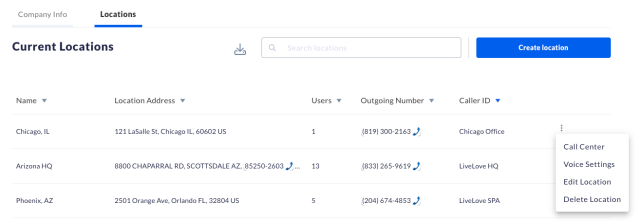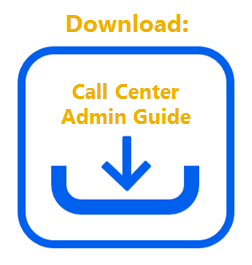The Call Center Wizard is a convenient way to set up a Call Center, guiding you through initial setup, call routing, and assigning agents.
There are three types of Call Centers configurable through the wizard:
- Call Queuing (Basic): Comes with features like entrance announcement, call distribution policies and inbound call information. Voicemail and forwarding are also included features.
- Call Center Pro (Standard): Comes with all Basic features and ACD sign in and sign out functions, as well as additional support for optional features like call recording, and Supervisor Dashboard.
- Call Center Enterprise (Premium): Supports all features of Call Center, with advanced features like inbound DNIS, and silent monitoring.
Navigating to Call Center from NextOS (If purchased after Dec. 2020)
Navigating to Call Center from Nextiva Voice (If purchased before Dec. 2020)
Setting up a Premium Call Center:
Once the Configuration Portal launches in a new tab, select Call Center on the left Navigation Pane, then select Call Centers under the Basic column.

You will see a list of Call Centers on the next page. To begin the Call Center Wizard, click the Add Call Center Wizard button.
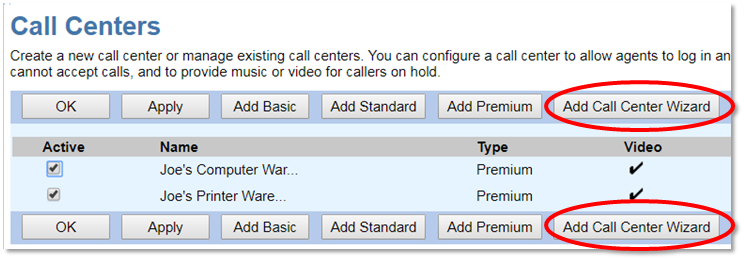
Select the Premium radio button, then select Next.

The next screen will be the first of a five-step process to configure the new Call Center.
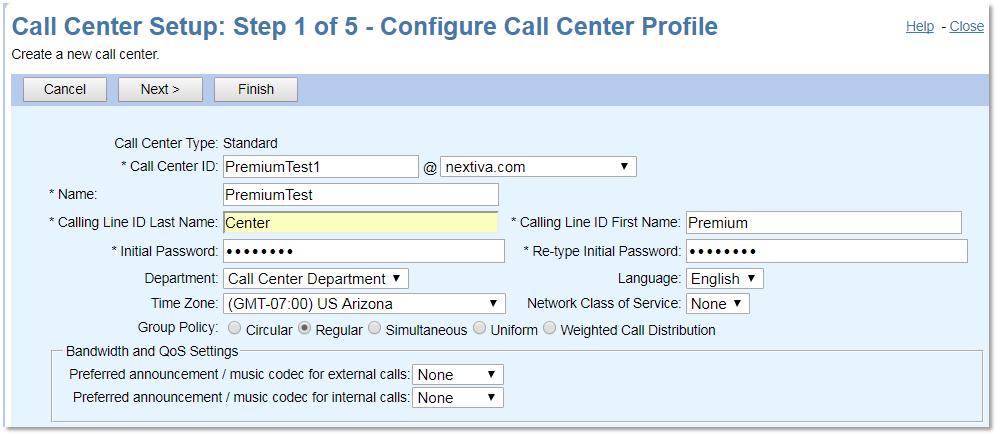
- Call Center ID: This unique ID assists in routing calls. The Call Center ID needs to be alpha-numeric with no special characters and no spaces.
- Name: A friendly name for the Call Center.
- Calling Line ID: When someone calls the Call Center, this is the name displayed on the receiving Agent’s device.
- Initial Password: This password will be used with third-party integration services. Must be 4 or more characters.
- Department: Gives Administrators the ability to departmentalize their phone system, a key component to Unity.
- Language: Currently English is the only language package Nextiva has available.
- Time Zone: Used for scheduling functions, reporting, and time-dependent call routing.
- Routing Type: Select one of the following options:
- Priority Based: When an agent becomes available to receive a call, the call from the Call Center with the highest priority (determined by the Call Center Routing Policy page) is offered to the agent.
- Skill Based: When an agent becomes available to receive a call, the call from the Call Center where the agent is most skilled is offered to the agent.
- Group Policy: How incoming calls will ring to agents. There are five different types to choose from:
- Circular: Sends the calls to agents one at a time, moving down the list of agents until someone answers. The next call will start ringing the agent where the last call left off.
- Regular: Rings the agents one at a time, always trying the agent at the top of the list and working its way down.
- Simultaneous: Rings all of the agents at the same time.
- Uniform: Agent phones ring one at a time in the order of idle time. The Call Center offers the next call to the agent who has been off the phone the longest.
- Weighted Call Distribution: Assigns each agent a percentage. The Call Center will then try to distribute the calls based on the configured agent percentages.
Additional settings on this screen include:
- Queue Length: This limits the number of people that can wait in queue for an agent. Calls will follow overflow treatment when the queue length is reached. Premium Call Centers can have a maximum of 525 callers in queue.
- Enable Video Support: This feature is not supported.
- Play Ringing When Offering Call: Once an agent becomes available, the caller will hear ringing instead of hold music while the call connects.
- Allow Callers to Dial “0”: If a caller presses 0, he/she will hear the Call Center voicemail. Configuring the Call Forwarding Busy option inside of the Call Center changes this option. When deselected, nothing will happen when the customer presses 0.
- Reset Caller Statistics: Resets an internal timer that tracks how long a caller has been waiting in the queue when transferring calls from one Call Center to another using Overflow or Bounce routing policies.
- Allow Agents to Join Call Center: Call Center agents can join and remove themselves from their assigned Call Centers.
- Allow Call Waiting on Agents: Sends calls to agents who are already on a call.
- Enable Calls to Agents in Wrap-Up: Agents will still get calls, even in Wrap-up. Wrap-up is the time the agent has after each call before the next call.
- Maximum Wrap-Up ACD timer: The maximum amount of time after the end of a call before the agent is back in the queue.
- Automatically Set Agent to State: Administrators can choose between available, unavailable, and wrap-up.
- Automatically Answer Calls After Waiting __ Seconds: Allows calls presented to agents to be answered automatically after the specified amount of time and rendered over an agent’s device speaker and microphone.
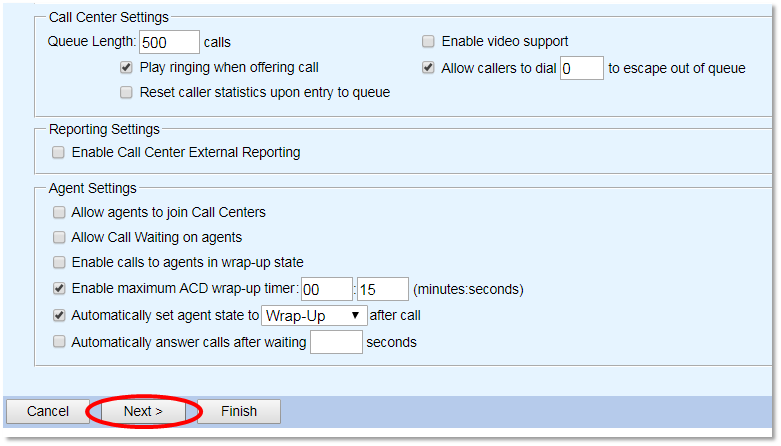
After filling out the required fields, select the Next button. Next, you will be presented with DNIS configuration settings. Configure the DNIS settings, if applicable, and click the Next button.
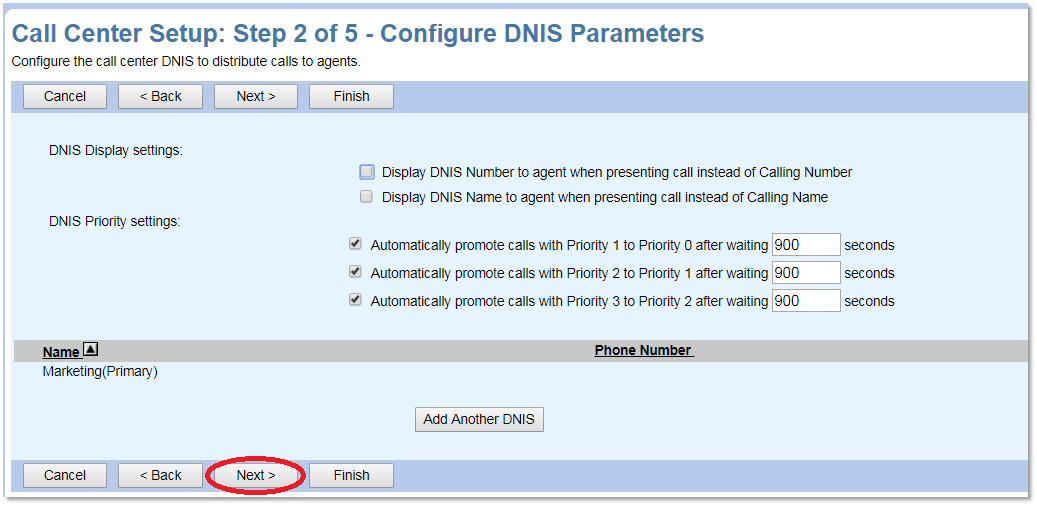
To assign agents, click the Search button in the upper-right to show all of the agents in the Group that can take calls. Select the agents desired and click the Add button to move them from the Available Agents field to the Assigned Agents field. Click Next when finished assigning agents.

Next, you can assign supervisors to monitor agents. Click the Search button to bring up all of the users in the Group that can be assigned as supervisors. Select the desired user(s) and click the Add button to move them from the Available Supervisors field into the Assigned Supervisors field. Then click Next.

From the drop-down field in the upper left-hand corner of the screen, select a supervisor. Select the Search button to the far right. A list of available agents to supervise is displayed in the Available Agents field. Select the agent(s) to supervise, then click the Add button in the middle to move them to the Assigned Agents field.
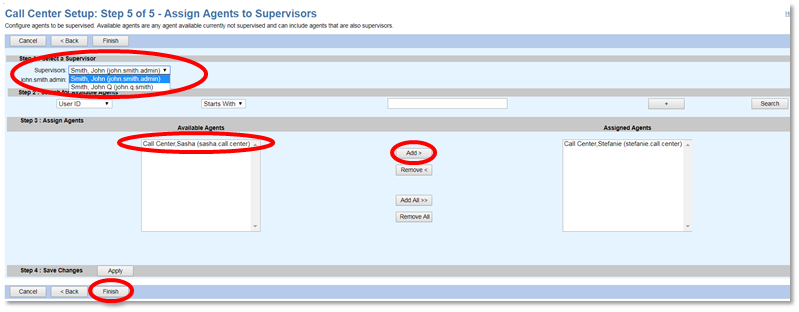
Click Finish to create the Call Center. To reach the Call Center, you will need to assign an extension or direct phone number. To do so from the main Call Center Profile screen at the Group level, select Addresses.
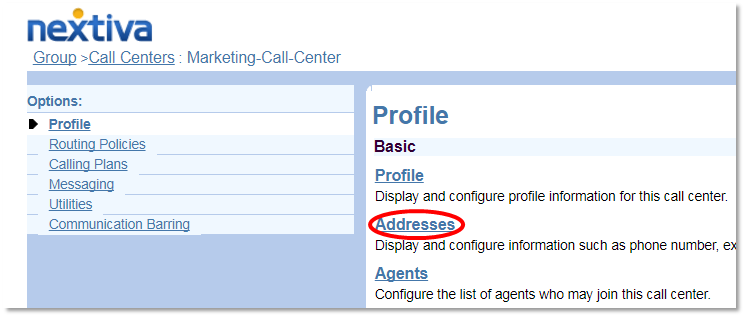
Select a phone number from the drop-down. The last four digits of the phone number may be automatically assigned as the extension. If you wish to change the extension, you may do that as well.
Your Call Center is now set up and configured! The next steps include configuring Announcements and having Agents join the Call Center.
